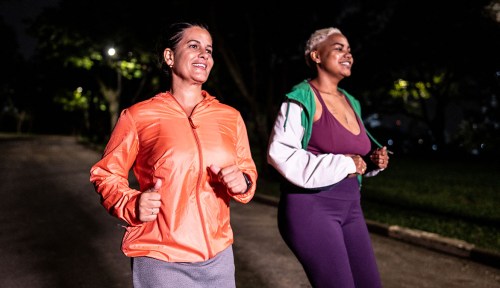Our editors independently select these products. Making a purchase through our links may earn Well+Good a commission
Feeling Sleep-Deprived? Here’s How to Program a Workout Routine That Helps You Catch Some Zzzs
Learn how to program a workout routine for better sleep. Activity can promote catching zzs, and a good night's sleep can improve workouts!

The most life-changing advice I ever received for my life-long sleep anxiety was ridiculously simple, and has turned out to be incredibly effective: Just don’t go to bed until you’re really tired. That idea somehow took the stress away from getting in bed, like there was no rush, no pressure—I could just go when I was good and ready.
Experts in This Article
But as a person with a day job, I do have an ideal range of time I’d like to turn off the lights, and waiting until my eyes are closing on their own doesn’t always fit that schedule. So I searched for something that would get me to that really tired place (without any sleep deprivation). And the magic key has turned out to be exercise.
I was able to figure out on my own what multiple studies have proven: That physical activity positively affects people’s ability to fall asleep, as well as their quality of sleep.
“When we’re active, we find that it leads to a more consistent and better sleep routine—longer, deeper, more refreshing—through the use of additional energy and the hormone release that exercise causes,” says Tess Barringer, a coach on the personal training app Future Fitness.
There’s actually a feedback loop between exercise and sleep that benefits both endeavors. Better sleep leads to more energy, which allows for better workouts. Better workouts can promote sleep, which also promotes recovery—making you able to crush your gym sess the next day.
“Exercise and sleep go hand-in-hand,” says Barringer.
While you can reap the pro-sleep benefits from any activity that gets you moving, there are actually some ways to specifically plan a weekly workout routine to promote better sleep. One recent study suggests that resistance training may improve sleep duration, while a combination of resistance training and aerobic exercise improves sleep efficiency (the amount of time you lay in bed before falling asleep). And Johns Hopkins Center for Sleep reports that at least 30 minutes of moderate aerobic exercise can lead to better quality sleep that same night.
However, Barringer notes that crafting a workout routine for better sleep is a personal endeavor that requires figuring out what works for you. Particularly because the time of day your exercise can make a big difference in how the activity affects your sleep cycle.
If you love working out at night…
For anyone who likes to exercise in the evenings, you are better off skipping vigorous HIIT sessions or other intense workouts, and instead doing moderate physical activity, which “could help with the release of adenosine, the chemical that encourages us to sleep, as well as top us off for the day energy-wise,” Barringer says. Aim for around 20 to 30 minutes a day of this type of activity, per CDC recommendations. And get it in at least three hours before you hit the hay so that you’ve got time to come down from the endorphin rush.
If you’re a morning exerciser…
“If mornings are your jam, research suggests that vigorous activity (unable to talk, focused more on catching your breath) could help you torch the extra energy that keeps you lying awake at night, while charging you up mentally for your day,” Barringer says. Since the CDC recommends 75 mins of vigorous cardiovascular activity weekly, Barringer notes this “is often sustainable in smaller bouts multiple times throughout your week.”
Make your workout routine work for you
You should also take other sorts of personal preference into consideration, such as focusing on moderate or vigorous activity you actually like doing. From there, “include 30 minutes of strength training into that routine to help take your sleep to the next level,” Barringer says. She gives the example week of “three 10-minute moderate intensity walks throughout the day, and one 30-minute resistance/strength-training session five days a week.” A plan like that would tick off the boxes for better sleep quality, duration, and efficiency.
Overall, the best course of action is to experiment, and then to see what sort of routine you actually stick with. Working with personal trainer, like Barringer at Future, could help make sense of it all.
“Just because the data suggests one thing, it doesn’t mean it’s right for you or your beautifully unique life,” Barringer says. “Sometimes any activity is better than no activity in supporting a whole-health minded lifestyle and unlocking new routines.” Good lifts, and sweet dreams!
A good nighttime wind-down can also be helpful. Try this bedtime stretch:
—reviewed by Angela Holliday-Bell, MD










